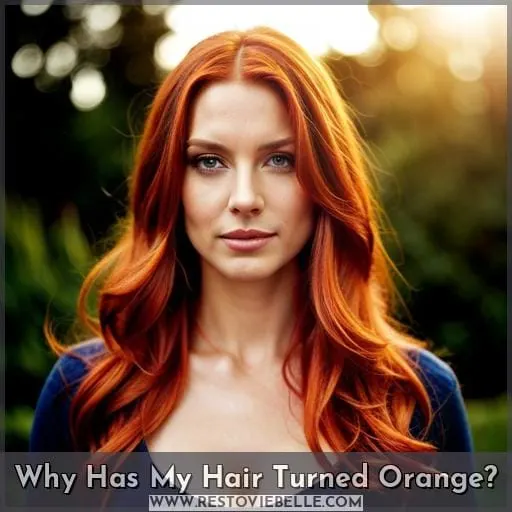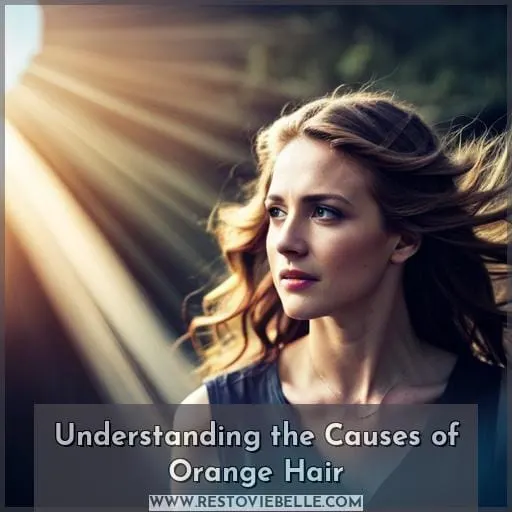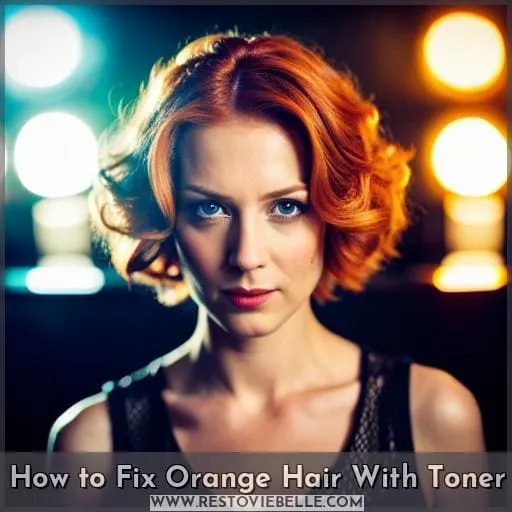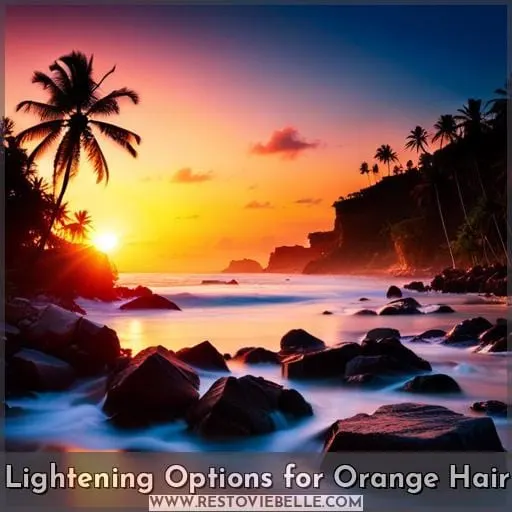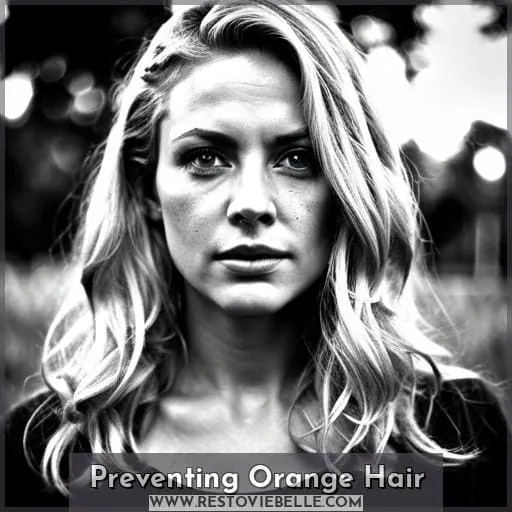This site is supported by our readers. We may earn a commission, at no cost to you, if you purchase through links.
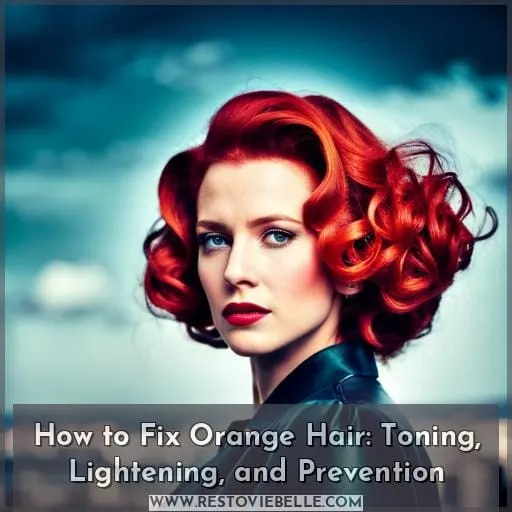 Picture a moment when you finally take the plunge and go for that new hair color. You’re so excited to see the results, but when it’s done all your dreams of beautiful blonde locks have been replaced with an unwelcome orange hue.
Picture a moment when you finally take the plunge and go for that new hair color. You’re so excited to see the results, but when it’s done all your dreams of beautiful blonde locks have been replaced with an unwelcome orange hue.
Whether from bleaching or using dye that was too dark for your original shade, this article will provide some tips on how to fix brassy tones in your tresses and prevent them from ever appearing again.
From toning with purple shampoo to lightening up at the salon, we’ll cover all bases on how to fix orange hair caused by bleach or other factors like chlorine water exposure.
Table Of Contents
Key Takeaways
- Use purple/blue shampoo to neutralize orange tones.
- Consider dyeing hair darker to cover up orange.
- Try salon treatments or an apple cider vinegar rinse to restore hair color.
- Seek professional help for severe cases of orange hair.
Why Has My Hair Turned Orange?
Are you wondering why your hair has turned orange? You may want to consider using purple or blue shampoo, dyeing your hair darker, lightening your orange hair at the salon, or even using an apple cider vinegar toning rinse.
These methods can help restore balance and neutralize unwanted tones in bleached-out locks.
Using Purple or Blue Shampoo
To counteract the orange tones in your hair, you can try using a purple or blue shampoo about once a week. It’ll take care of any brassiness and leave you with beautiful blonde locks. Purple shampoo specifically works to neutralize yellow tones, while blue shampoos work to tone down warm colors.
You can also choose to consult with a professional colorist for toning techniques if needed. Alternatively, there are DIY methods like creating homemade masks with honey and conditioner that help reduce orange hues.
Incorporating natural remedies like apple cider vinegar rinses into your haircare routine can also yield optimal results.
Don’t forget proper maintenance, such as protecting hair from UV rays by wearing hats or scarves. Additionally, avoiding chlorinated water altogether will go a long way in preventing future issues.
Dyeing Your Hair Darker
Dyeing your hair darker is an option to counteract orange tones and achieve a cooler blonde hue. Choosing the right toner for dark hair can be difficult, so professional help may be necessary. A DIY toner of conditioner mixed with food coloring or semi-permanent dye can also work to tone down the color.
If you already have lighter colored hair that’s beginning to fade, there are special remedies available for lightening it back up again without turning it orange in the process.
With these tips and tricks in mind, anyone should be able to turn their orange locks into beautiful shades of light browns with ease!
Lightening Your Orange Hair at the Salon
If your orange hair needs more than a simple toning fix, then consider visiting the salon for lightening treatments to restore your desired shade. You can also get an in-salon toner or opt for bleaching at home with professional advice.
However, it’s important to maintain hair health and use UV protection when outdoors if you choose this route.
Swimming activities should be avoided as chlorine and saltwater can cause further color oxidation of the strands, leading to yellow/orange tones.
Using an Apple Cider Vinegar Toning Rinse
For an all-natural toning solution to neutralize orange hair, try using an apple cider vinegar rinse! This method can be used weekly and has been known to reduce unwanted tones in as little as five minutes for up to 80% of people who’ve tried it.
Benefits include gentle exfoliation of the scalp, helping balance pH levels, closing cuticles for extra shine and smoothness, and conditioning the hair while also helping fight dandruff.
To apply ACV correctly, dilute it with equal parts water, then spray or pour onto dampened strands before rinsing out after a few minutes.
While this DIY remedy is often effective, purple toners like shampoo may work better depending on your situation.
Understanding the Causes of Orange Hair
Are you concerned about your orange hair after bleaching? Understanding the causes of orange hair is crucial to fixing it. Hair color theory and toning can help explain why underlying pigments, chlorinated or salty water, and bleaching all affect the pigment in your hair.
With the right products and techniques, you can restore your natural hue while helping protect it from further damage.
Hair Color Theory and Toning
To neutralize orange tones, try toning your hair with purple shampoo. Choosing the right product is key, as blue toning shampoos help reduce warm colors like red and yellow, while purple helps counteract brassy blonde shades.
When using a toner, apply it to damp or dry hair following the instructions on the bottle.
For DIY solutions, you can mix together color conditioners and natural ingredients such as honey to create custom mixtures that work best for you.
Ultimately, by incorporating these tips into a routine, you will help turn orange hair back to blonde without damaging delicate locks!
Role of Underlying Pigments
Even if you use the best toners, underlying red and orange pigments in dark hair can still cause brassiness, like a ray of sunshine peeking through storm clouds. Understanding these pigments is essential to fixing an orange hue after bleaching.
Bleaching impacts these undertones as it strips away pigment and protein from hair strands. The more intense the lightening process, the bigger chance for yellow or brassy tones to appear on your locks! To avoid this issue, consider color theory principles when starting a new look.
For example, purple shampoo neutralizes yellow-orange hues, while blue shampoos tone down warm colors.
Furthermore, with understanding comes power, so make sure you’re always informed about any changes in your mane’s appearance due to bleaching!
Effects of Chlorinated and Salty Water
Chlorinated pools and salty water can cause brassiness, leading to orange tones in your hair.
To prevent discoloration from chlorinated and salty water exposure, wear hats or scarves for protection when outdoors and use filtered water to wash your hair. Additionally, try using a toner or natural remedies such as an apple cider vinegar rinse or honey mask on occasion to tone brassy hair before it becomes too noticeable.
Lastly, be sure to protect against both UV rays and chlorine/saltwater damage if you want healthy vibrant locks of any hue!
- Wear hats/scarves when outdoors for UV ray protection
- Use filtered water instead of tap while washing the hair
- Try using a toner occasionally to tone brassy strands
- Utilize natural remedies such as ACV rinses & honey masks
- Protect against both UV radiation & chlorine/saltwater damage
Impact of Bleaching on Hair Pigment
Uncovering the cause of your orange hair starts with understanding how bleaching affects hair pigment. When bleach is used to lighten or color your hair, it removes both pigment and protein from the shafts.
The more you bleach, the lighter and less pigmented your locks become. This can potentially result in an orange hue if inadequate lightening occurs.
To prevent this outcome, consider seeking professional help for severe cases. Additionally, using products like purple or blue shampoos regularly can help tone down warm colors when necessary. Glazing or dyeing may also be beneficial, depending on the severity of discoloration due to the bleaching process’s impact on natural pigments and changes in the strands.
How to Fix Orange Hair With Toner
Are you struggling to get rid of orange hair after bleaching? Toner can be a great solution for fixing the issue. Here, we will discuss details on choosing the right toner, using it in the process for orange hair, and why purple shampoo is beneficial in this context.
Choosing the Right Toner
Finding the right toner is key to achieving your desired hair color. When selecting a toner, consider its benefits, techniques, and how it will interact with other products used in the process.
- Toning neutralizes orange tones with purple shampoo.
- Blue shampoo tones down warm colors.
- Use once a week or as needed for maintenance.
- DIY Purple Hair Toner using conditioners and colors can be an option too!
Professional help may be necessary if you’re looking for results that last longer or if you have severe cases of orange hair post-bleaching process.
Toning Process for Orange Hair
Tone your tresses to tackle the orange tones and turn them into a more flattering hue. Choose a toner that works best for your color-treated hair. Look for one with purple undertones if you want to neutralize unwanted yellow or orange hues.
Use glossing color instead of box dye. Apply it to damp hair in sections, starting at the roots and working down towards the ends.
Purple shampoo will also help maintain cool toned locks between washes. Its violet pigments counteract yellow/orange tones while restoring shine and softness too. For extra vibrancy, opt for glaze or gloss application every six weeks plus regular trims.
Using Hair Gloss for Toning
For a more subtle approach to neutralizing orange tones, try using hair gloss for toning. Hair gloss helps enhance shine and natural color while keeping your hair healthy. Benefits include adding vibrancy and restoring moisture balance in the cuticle layer of the hair shaft.
Toning with a gloss is less harsh than traditional toners or bleaching, yet still offers results similar to those achieved by lightening products. When applying the gloss, it’s important to avoid using hot tools beforehand as this can cause excessive drying out of the strands and damage over time.
Instead, opt for a cleansing system like Olaplex Step 1 & 2 before applying the product with a brush or comb evenly throughout dampened locks from roots to ends.
Additionally, it’s crucial to protect your newly treated tresses from UV rays, which may further strip away color. You can do this by wearing hats or scarves when outdoors. By following these tips, you can achieve a beautiful, toned look without compromising the health of your hair.
Benefits of Purple Shampoo for Toning
Purple shampoo can be your best friend when it comes to toning orange hair, like a trusty sidekick in an adventure. It has many benefits when used correctly and will help you achieve the desired tones quickly and easily.
Purple shampoo helps neutralize yellow-orange tones and counteracts brassiness caused by chlorine or saltwater exposure. It also refreshes faded red dyes and tones down warm colors to create cool blondes.
Moreover, purple shampoos are gentle enough for weekly use without harsh chemicals. They are great for maintaining blonde shades over time with regular use as they keep unwanted brassy hues at bay while nourishing your hair with essential vitamins and minerals needed for healthy locks.
With all these amazing benefits of purple shampoo, you’ll have beautiful tresses in no time!
Lightening Options for Orange Hair
If you’re looking for a way to fix orange hair, lightening your locks is one of the best options. You can choose to lighten your hair into a cooler blonde shade, restore the natural moisture balance before re-bleaching or using dye, bleach, or toner on orange roots.
For an even more natural approach, try homemade masks with ingredients like honey and conditioner that help neutralize orange tones.
Lightening Hair to a Cooler Blonde Shade
Lightening your locks into a cooler blonde shade is the perfect way to combat orange tones and get back to that natural golden hue you love. Hair color science makes this transformation possible through lightening processes and toning techniques.
Unlock new possibilities with:
- Cooler Blonde Shades – choose shades like ash, platinum, or beige for a subtle update
- Blonde Transformation – use bleach or dye for longer-lasting results when transitioning from dark hair colors
- Lightening Process – gradually lighten hair over time with repeated applications of bleach
- Toning Techniques – neutralize unwanted orange hues using purple shampoos & DIY masks
Embrace an exciting journey as you take control of your look by experimenting with lighter shades!
Restoring Natural Moisture Balance Before Re-Bleaching
Before re-bleaching, it’s essential to restore your hair’s natural moisture balance for the best results. Consider protecting your hair from UV rays with hats or scarves and using filtered water when washing.
Keep in mind that chlorinated or saltwater can cause oxidation of existing color, so avoid wetting your locks in these environments as much as possible.
Maintaining healthy levels of hydration is key to achieving a lighter shade without unwanted orange tones appearing after bleaching has taken place.
With the right considerations and maintenance tips, you’ll be able to get stunning blonde shades without any brassy hues!
Fixing Orange Roots With Dye, Bleach, Toner, or Natural Remedies
If you’re looking for a way to tackle orange roots, consider dyeing, bleaching with care, toning up, or trying natural remedies. Choose the right technique. Dyeing techniques can cover up yellow and orange tones.
Natural remedies, such as apple cider vinegar rinses, may help neutralize hair color. When considering bleaching, make sure to take precautions to avoid further damage. Selecting the right toner is key when attempting to fix brassiness issues naturally.
There are professional root fix solutions available or you can try a DIY approach. Do your research carefully and don’t be afraid to ask an expert for advice if necessary. The solution you choose will depend on the results you want and how much time, effort, and money you’re willing to commit.
Homemade Hair Masks to Neutralize Orange Tones
Try using homemade hair masks to naturally neutralize any orange tones in your bleached hair! There are many homemade solutions out there, from DIY hair masks to natural remedies. You can easily make a mask by combining conditioner and food coloring or purple/blue dye.
For more complex recipes, you can use ingredients like honey and lemon juice, which have natural properties that can help restore the desired shade.
With patience and some creativity, these homemade solutions can be highly effective against orange tones in your locks.
Preventing Orange Hair
Protecting your hair from orange tones requires taking several steps to prevent damage. To start, protecting hair from UV rays with hats or scarves is a must; using filtered water when washing keeps minerals out of the equation that may otherwise cause brassiness.
Additionally, avoiding wetting hair in chlorinated and saltwater helps reduce color oxidation while maintaining a healthy moisture balance.
Protecting Hair From UV Rays
Shield your hair from sun damage with protective headgear like hats or scarves! Sun protection is essential for maintaining healthy locks. UV rays can strip color, dry out strands, and cause breakage. Invest in a hat that blocks ultraviolet radiation, especially if you’re spending time outdoors.
Look for one made of lightweight fabric to ensure breathability and comfort during summer months. To maximize protection, use sunscreen specifically designed for hair before heading outside.
You could also purchase products containing UV-blocking ingredients to help decrease sunlight exposure when wearing lighter materials such as cotton bandanas or turbans on hot days without worrying about damaging effects caused by intense sun exposure.
Using Filtered Water for Washing Hair
Rinse your hair with filtered water to avoid minerals that can cause brassiness. Filtered water benefits go beyond just removing harsh chemicals like chlorine, as it also helps reduce heavy metals and other impurities which can have an effect on the color of your hair.
Hair washing tips include avoiding chlorinated or saltwater when wetting the hair, and using a filter for showering. The quality of water you use to wash and rinse your tresses plays an important role in preventing orange hues from developing due to mineral deposits found in hard tap waters such as iron oxide (rust).
Prevention of orange hair starts by understanding how chlorine affects our hair’s pigment levels before opting for filtered H2O instead!
Avoiding Chlorinated and Saltwater Exposure
To prevent orange hair, avoid swimming in chlorinated or saltwater pools. UV rays can also cause brassiness, which can be prevented by wearing hats or scarves for protection. Treating your hair with natural remedies like hollyhock herbs and an apple cider vinegar rinse is great for maintaining healthy locks and counteracting any unwanted yellow tones that may develop over time.
Regular use of purple and blue shampoos is a must to counteract warm colors. Restoring the natural moisture balance will help you achieve desired results when re-bleaching your hair if needed.
Maintaining Hair Health and Moisture Balance
Keep your hair healthy and hydrated to prevent orange tones from developing. Use a UV-protecting hat or scarf when out in the sun, and use filtered water for washing your hair instead of tap water, which can contain minerals that cause brassiness.
Make sure to moisturize regularly with conditioners, oils, or masks. This will help maintain the moisture balance of your hair and reduce oxidation damage caused by bleach products.
For extra protection against UV exposure, you could try using leave-in conditioners that contain shea butter or coconut oil. Both are great at providing natural SPF protection for the scalp while helping retain moisture within strands.
Quick Fixes for Yellow Hair
If you have yellow hair after bleaching, there are several quick fixes that can help counteract the tones. One method is using a toner to neutralize yellow hues, while another option is going blonde in order to correct the tone of your hair.
For those looking for more subtle solutions, purple shampoo may be used as well to reduce any brassy or overly warm colors found in your strands.
Using a Toner to Counteract Yellow Tones
Tone with a purple shampoo to neutralize yellow tones and restore your hair’s original shade! A toner offers many benefits, such as reducing brassiness and protecting against future discoloration.
Here are some tips for proper application:
- Use the shampoo once a week.
- Massage it into wet hair.
- Leave it on for 5-10 minutes.
- Rinse thoroughly with lukewarm water.
Toning is more effective than dyeing in removing yellow hues from bleached blonde hair, but it may require professional help in severe cases. When using purple shampoo, remember that the longer you leave it in your hair, the better results you’ll achieve.
Going Blonde to Correct Yellow Hair
If you’re looking for a dramatic change, going blonde can help correct yellow tones and leave your hair with an ultra-cool finish. Achieving this look requires some maintenance, though. Blonde transformation requires a colorist or DIY toning techniques to maintain the desired shade.
To keep blonde hair healthy and radiant, use sulfate-free shampoo and conditioner formulated specifically for blondes. These products will nourish while gently cleansing away dirt build-up without stripping color.
It’s also important to regularly tone yellow hairs with purple or blue shampoos. These shampoos counteract warm shades of gold/yellow. Additionally, use deep conditioning treatments weekly to replenish lost moisture from bleaching processes over time.
So if you want a brighter hue than natural roots allow, go ahead and take the plunge into golden waves of sunshine!
Purple Shampoo for Neutralizing Yellow Tones
Blast away yellow tones with purple shampoo! A toning technique used to neutralize warm hues, purple shampoo can be found in beauty stores and online. Benefits include restoring blonde hair color without further bleaching, removing brassiness from gray or silver hair, and using less product than traditional dyes or lighteners.
DIYers may try their hand at homemade masks for mild cases while professional coloring is recommended for extreme cases.
Conclusion
It’s estimated that over 50% of bleached hair will turn orange or yellow at some point. To prevent orange hair and fix it when it does occur, understanding the causes and using the right products and techniques are essential.
From knowing the role of hair color theory and toning to using purple and blue shampoos, dyeing, lightening, and natural remedies, this article has provided an in-depth understanding of how to fix orange hair.
With the right knowledge and methods, you can restore your hair to its original color and maintain a healthy, vibrant shine.
